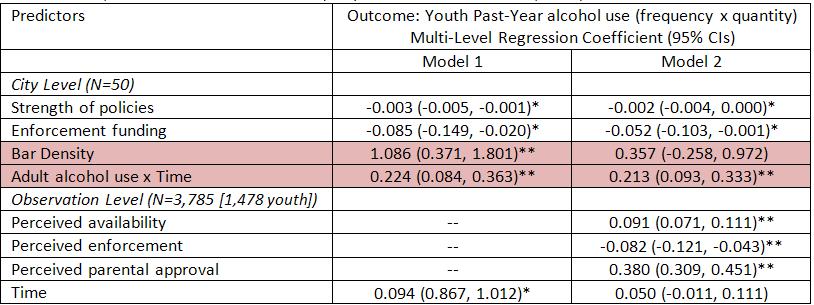The DRAM, Vol. 10(4) – Bar none: Local drinking environment linked to adolescent drinking behaviors
Alcohol policies are often set at the national or state level. However, enforcement of these policies, and establishment of regulations to guide alcohol service and accessibility, occur at the local level. As a result, communities within a single state can vary widely in their drinking environment. This week, The DRAM reviews a study by Paschall and colleagues (2014) examining how (1) the local alcohol environment and (2) adolescent alcohol perceptions jointly influence adolescent drinking behaviors. This review is part of our Special Series on Alcohol Awareness Month.
Methods
- Participants were adolescents from 1,543 households (50.4% of recruited households) spread across 50 diverse non-contiguous California cities.
- The current study includes 1,478 adolescents, age 13-17, who completed at least one survey and lived in the same city for all three years of data collection.
- Adolescents completed surveys once a year for three years about:
- their past-year drinking behavior (i.e., how many days they had a drink in the past 12 months and how many drinks they had per drinking day)
- perceived alcohol accessibility and enforcement of underage drinking laws
- perceived parental approval of underage drinking behavior.
- The researchers also collected information from each city on
- strength of their policies to prevent underage drinking1
- funding received to enforce underage drinking laws
- bar density (i.e., number of bars per road mile)
- average level of adult alcohol use, derived from a previous household survey.
- The researchers conducted a multi-level regression analysis to determine which city-level variables and which youth-level variables predicted youth alcohol use.
Results
- Both city- level variables and youths’ alcohol-related perceptions influenced youth past-year alcohol use (see Figure).
- At the city level, weaker policies, less enforcement funding, and greater bar density all predicted higher past-year alcohol use.
- At the individual level, perceptions of greater alcohol availability and parental approval and weaker enforcement predicted higher past-year alcohol use.
- The highlighted rows in the Figure display two interesting findings:
- Greater bar density predicted higher youth alcohol use, but this effect was mediated by youth perceptions of availability and approval. In other words, youth in cities with higher bar density perceived greater alcohol availability and parental approval than youth in cities with lower bar density (not shown in this Figure, and these perceptions in turn predicted their alcohol use.
- There was an interaction between adult alcohol use and time, such that in cities with greater adult alcohol use, youth past-year drinking increased more steeply across the three study waves.
Figure. Relationships among local alcohol environment, adolescents’ perceptions of the local alcohol environment, and adolescent alcohol use (adapted from Paschall et al., 2014). Note: Researchers used a multi-level modeling technique that allows for inclusion of city-level and individual level effects in the same model. Model 1 includes city-level variable (listed within the table), as well as city-level and youth demographics. Model 2 includes all of the variables in Model 1 plus youth perception variables. *p<.05; **p<.01. Click image to enlarge.
Limitations
- The sample of adolescents might not be representative of all adolescents in those cities, and attrition might have introduced bias into the results.
- Adolescent measures relied on self-report and recall of past year drinking, which could introduce bias.
- The city-level measure of enforcement measured funding of enforcement, not necessarily strength or visibility of enforcement.
Conclusion
The current study suggests that aspects of the overall alcohol environment within a city influence adolescent drinking and do so partly through their effects on adolescents’ perceptions of the availability of alcohol and permissibility of underage alcohol consumption. However, there are other possible interpretations. It is possible that the link both the local alcohol environment (e.g., availability, policy, and enforcement) and youth perceptions and drinking are both driven primarily by adult alcohol attitudes and use. Future research could replicate this study but collect data about both adult and adolescent alcohol use over time as it relates to local environment to further understand the mechanisms behind these relationships.
– Sarah Nelson
What do you think? Please use the comment link below to provide feedback on this article.
References
Fell, J. C., Fisher, D. A., Voas, R. B., Blackman, K., & Tippetts, A. S. (2008). The relationship of underage drinking laws to reductions in drinking drivers in fatal crashes in the United States. Accident Analysis and Prevention, 40, 1430-1440.
Paschall, Mallie J., Lipperman-Kreda, Sharon, & Grube, Joel W. (2014). Effects of the local alcohol environment on adolescents’ drinking behaviors and beliefs. Addiction, 109, 407-416.
________________
1 Researchers used an existing coding scheme (Fell, Fisher, Voas, Blackman, & Tippetts, 2008) to grade each of the 50 cities on the strength of their policies to prevent underage drinking.
